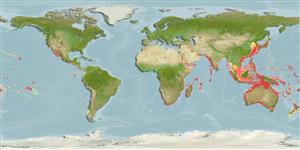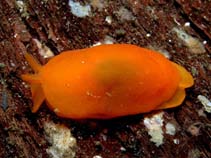Berthellina citrina (Ruppell & Leuckart, 1828)
Orange gumdrop| Native range | All suitable habitat | Point map | Year 2050 |

|
| This map was computer-generated and has not yet been reviewed. |
| Berthellina citrina AquaMaps Data sources: GBIF OBIS |
Classification / Names Common names | Synonyms | CoL | ITIS | WoRMS
Gastropoda | Pleurobranchida | Pleurobranchidae
Environment: milieu / climate zone / depth range / distribution range Ecology
Benthic; depth range 0 - 150 m (Ref. 7727). Tropical
Distribution Countries | FAO areas | Ecosystems | Occurrences | Introductions
Circumglobal tropical and temperate seas.
Length at first maturity / Size / Weight / Age
Maturity: Lm ? range ? - ? cm Max length : 3.0 cm TL male/unsexed; (Ref. 844)
Short description Morphology
Life cycle and mating behavior Maturity | Reproduction | Spawning | Eggs | Fecundity | Larvae
Main reference
References | Coordinator | Collaborators
Burn, R. 2006 A checklist and bibliography of the Opisthobranchia (Mollusca: Gastropoda) of Victoria and the Bass Strait, southeastern Australia. Museum Victoria Science Reports 10:1-42. (Ref. 7727)
IUCN Red List Status
(Ref. 130435: Version 2025-1)
CITES status (Ref. 108899)
CMS (Ref. 116361)
Threat to humans
Human uses
| FishSource |
Tools
More information
Max. ages / sizes
Length-weight rel.
Length-length rel.
Length-frequencies
Mass conversion
Abundance
Internet sources
BHL | BOLD Systems | CISTI | DiscoverLife | FAO(Publication : search) | Fishipedia | GenBank (genome, nucleotide) | GloBI | Gomexsi | Google Books | Google Scholar | Google | PubMed | Tree of Life | Wikipedia (Go, Search) | Zoological Record



